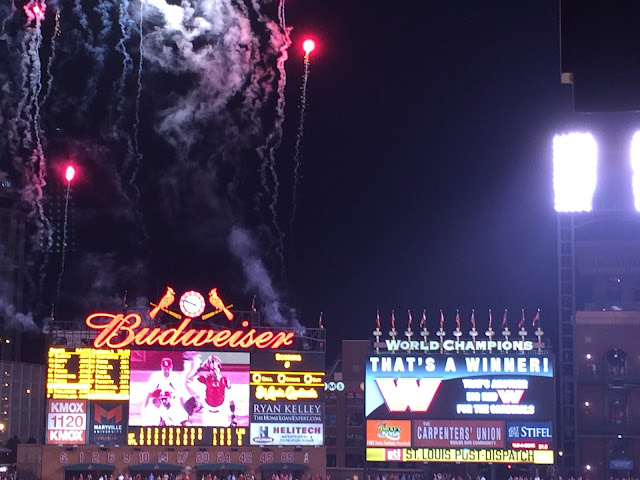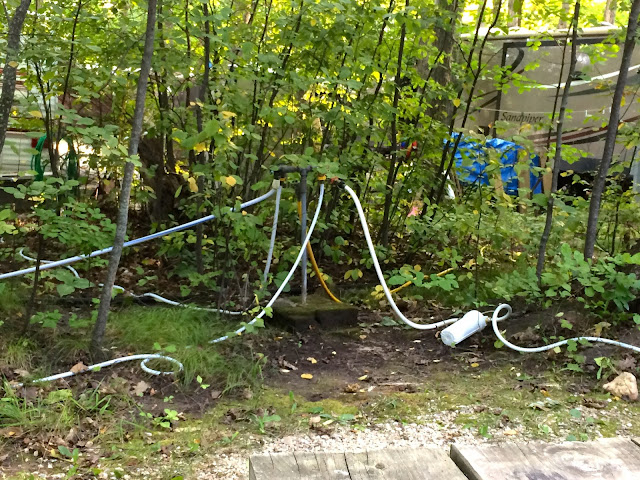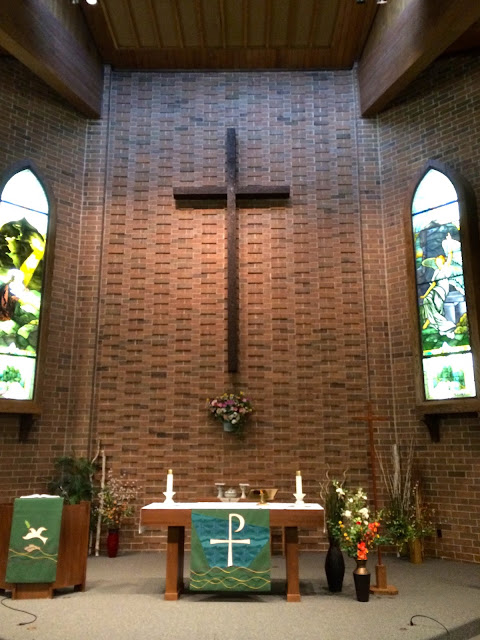Fairview,
IL to Duluth, MN August 2015
We continue to use Fairview, IL, as our home base and have a
great spot to park Abe. Being here has
given us a wonderful summer seeing family and friends, visiting places we
remember from growing up here, and discovering all the wonderful new changes
that have come about over the last 50 years.
I won’t bore you with all those details and will get on to the
travelling adventures we have had. I’ll
have to do this in installments, though!
We’re just having too much fun to keep up with my blog…and that’s a good
thing.
Jerry’s brother Don and sister-in-law Sally live east of St.
Louis (about 4 hours away) and, along with Jerry, are big Cardinals fans. (I, of course, continue to root for the
Cubbies!) We drove to St. Louis to see a
ballgame on August 17, taking us on a route through the wilds of historical
Illinois.
During our childhoods the Chautauqua National Wildlife Refuge,
on the western bank of the Illinois River at Havana, IL, was “Norris Farms”, a
several-thousand-acre feedlot. Coming
down over the Illinois River bluff we once saw thousands and thousand of cattle
standing on concrete, being readied for Chicago slaughter houses. Since 2000, the concrete has been removed,
the dikes torn down and the land has once again flooded. The land has returned to its natural state
and is quite a sight to see.
Crossing the Illinois River at Havana (soon after driving
through the little town of Cuba!) gave us views of all the barge traffic. Havana has quite a reputation as a gambling
river town and supposedly characters like Al Capone would gamble at the local
clubs.
Don and Sally were old hands at getting in to St. Louis to
see a baseball game and we were delighted to use their expertise! We took a shuttle bus from Fairview Heights,
on the the east side of St. Louis and were deposited right outside the
stadium. The stadium was in downtown St.
Louis and driving there, although certainly possible, would have been a
chore. It was much nicer to let an
experienced driver to the “heavy lifting”!
What a place!!
Obviously baseball is a big-time operation. We saw a huge meeting center attached to the
ball field, and of course the stadium itself would seat the population of an
average-sized city!
Don, Sally, and Jerry were certainly dressed appropriate in
their “Cardinal Red!”
It was a hot and humid afternoon and evening, but in spite of
that the stadium was almost full for the game.
About 70,000 people were there to watch!
We arrived about 2 hours before the game and were able to
wander through this vast complex. I
thought it was good planning on someone’s part to be sure that the famous St.
Louis arch was visible from the stands. It
was mind-boggling to consider how many gallons of soft drinks and beer, hot
dogs and buns..toilet paper!!...it took to support the fans at this ballgame.
The Cards played the San Francisco Giants and won 2-1! We even got to see a home run, with the
attendant fireworks.
August 20, we fired up Abe and hit the road for a 3-week tour
of the upper Midwest. Even though we had
lived in the Midwest the first 18 years of our lives, neither of us had seen
much of the northern tier of states and we were ready to explore. Our first destination was Door County,
Wisconsin. After an overnight stop in
Stoughton, WI, we arrived at the Egg Harbor Campground on August 21. The weather was nice and cool – a great
relief after several hot and humid weeks in Fairview. The campground was busy but so well designed
that we hardly saw anyone! Imagine
having a campfire in August!
We did shake our heads a little bit over the campgound’s
unique water delivery system, but it all seemed to work. We decided that because of the potential for
severe winters, the campground folks keep the water lines above ground and pull
them in about the end of October.
We did all the tourist stuff, including a fish boil at the
Old Post Office Restaurant in Sisters Bay.
It was quite a unique process. The Lake Michigan whitefish was caught by
local fishermen and prepared outside over a roaring open fire. Small
potatoes and onions were boiled first and the fish chunks were then dropped
into the steaming kettle. When the oils
from the whitefish rose to the top of the kettle, kerosene was added to the
flames creating the "boil over," spilling the fish oils over the side
and signaling that the catch was ready to serve. Quite a spectacle! This particular fish boil restaurant had just
been filmed for a Food Network show and the fish boiler guy made sure we had the
info to catch him on TV.
The Door Peninsula is a long, thin finger of land which juts
north into Lake Michigan. Early French
voyageurs experiencing violent seas in the passage between the peninsula and
Washington Island named the passage Porte des Mort" which translates as
"Door of the Dead." When deciding on a name for a new county to
include the entire peninsula in 1851, the Wisconsin Legislature decided to drop
the latter part of the name, and settled on Door County. Lighthouses to keep the heavy shipping
traffic out of harm’s way were a necessity and many of those historic
lighthouses are still in operation. We
found them fascinating to visit.
In the photo above, I was standing on the boardwalk leading
to the lower rangelight at Baileys Harbor.
The only lighthouse we climbed was at Cana Island. To access this light, we walked across a
causeway to Cana Island and then up the 97 steps to the top. This was still an operating lighthouse,
safely bringing ships into the harbor.
The day we were there it was partly cloudy and windy, providing dramatic
views of scudding clouds and choppy water.
Not a day we would want to be cruising. In the “olden days”, the light burned lard, brought from the
mainland in ships. Today, of course it
was all electric and very efficient. Can
you imagine carrying warm lard up 97 steps?
The lighthouse at Sturgeon Bay protected the entry into Ship
Canal, connecting the bay with Lake Michigan.
We couldn’t visit the lighthouse, since it was on an active Coast Guard
station, but saw a Coast Guard ship, out for a run on Ship Canal.
Cave Island Point, a county park inside a state park, was on
the east side of the peninsula, on the shore of Lake Michigan. This eroded rock wall overhanging the water
provided a glimpse of the backbone of Door County: the Niagara Escarpment. Jerry and I enjoyed learning a little bit
about the geology of the area: that
this dolomite limestone “ridge” continues on to terminate at Niagara Falls. Cool
As was our custom to find a church to attend, Sunday, August
23, found us at Bayside Lutheran Church in Sturgeon Bay. We met Joan and Jef (yes, 1 “f”), who were
ushers that day and who invited us to brunch with them after church. The service itself was very traditional “high
church” with beautiful music, including a very talented cellist. Another great experience at a warm and
welcoming local church.
Sunday afternoon we toured the Sturgeon Bay Maritime Museum,
another and filled in some of the gaps in our understanding of the area. A great museum and well worth the visit!
I don’t want you to think we were shirking our mission to
seek out local microbreweries. We found
this quaint little spot in the middle of the peninsula and enjoyed their
creations.
Tuesday, August 25, we left Door County and headed for Green
Bay, with some trepidation. As long time
Chicago Bears fans, it did feel as though we were entering the lion’s den, but
we persevered. We found a great camp
ground…the Brown County Fairgrounds. The
fair had ended the day before and, except for the clean up crews, we had the
place to ourselves. Was it beautiful…no,
but we had plenty of power, which was all we needed. Since the fairgrounds was not busy, we were
able to park on the asphalt and not on the grass, where I am quite sure we
would have sunk.
We had two objectives in Green Bay…visit Lambeau Field and
see my nephew’s family in Appleton, south of Green Bay. We successfully did both.
We took a guided tour of Lambeau Field and even purchased tickets
to the Hall of Fame…not easy when one’s heart belongs to Da’ Bears! Of course the stadium was quite impressive, seating
80,000. Even more impressive was the
support the city of Green Bay has given the Packers to keep this a viable
operation. Big time pro football in a
city of 15,000…they were doing it right!
I’m sure you have heard the stories about the difficulty of acquiring
season tickets to Packers Games. The
wait time is about 115 years, given the current rate of turn over! One’s position in line on the wait list can
be willed one’s children! These people
are serious about football.
Jerry practiced his Lambeau Leap after the tour was
over. I suspected he wasn’t the first
one to do this.
Did you know that the tradition during the Packers Training
Camp is for the local kids to bring their bikes to the stadium for the players
to ride back and forth to the practice field?
This practice started in the 1950’s and continues today. The story was told that sometimes the bike a
player picks to ride is entirely too small, so the player tucks the bike under
one arm and the child to whom the bike belongs under the other arm. That would be a picture!
My nephew Mark Rask, his wife Danielle, and their sons Levi,
Micah and Gabe met us at Buffalo Wild Wings in Appleton. We had a busy, chatty evening with them. We will see them again in October when they
come to Illinois for a little family reunion.
Mark and Danielle’s oldest son, Levi, said he thought it was really fun
“meeting Daddy’s aunt and uncle.” So
sweet.
It was no surprise to us that Wisconsin was full of
interesting, tasty microbreweries. We
enjoyed “Titletown Brewing” in Green Bay very much. It was situated in an older part of the city,
near the Fox River, in any area undergoing renewal. Many towns and cities we explored during this
trip were making a huge effort to bring back the older parts of their
downtowns, often with spectacular results.
Thursday, August 27, we were on the road again and made our
way to northern Wisconsin and the UP of Michigan. We spent the night at “Hiawatha Trailer
Resort” in Woodruff, WI, just north of Menocqua, WI. We explored Minocqua…very touristy but still
an interesting little town. During our
stop at Menocqua Brewing Company we had a delightful conversation with Chris
and Michelle from San Antonio. It was
just one of those random conversations over beer on an outdoor deck above the
lake that made our travels so memorable.
We took a roundabout route from Woodruff, WI, to Duluth, MN,
so we could see some of the country in Michigan’s UP where Don and Sally ride their
snowmobiles. We stopped for lunch at the
highly recommended J&W’s BBQ and walked by the famous Bergland Bay Bar. Apparently these places were crazy busy in
the winter but were pretty quiet in August!
The owner of the Bay Bar had a web cam, available for viewing from his
Facebook page, to give the winter tourists a weather heads up.
Our campground in Duluth (or as Judee Gladen Berg’s father
used to say, “Do-Loot”) was one of our more unique. We parked on the asphalt at Lakehead Boat
Basin, where boat are stored “on the hard” during the winter. We had heard about this spot from Jon and
Norma Owens, RVing friends from Renton, WA.
What a great place! The marina is
just east of the lift bridge, bringing ships into the Duluth Harbor from Lake
Superior. We were an easy walk from the
waterfront area full of shops, restaurants and museums.
We wandered all over downtwon Duluth – and explored the
waterfront park and museum. The museum
published a daily shipping report to describe ships in the harbor or due in
that day. Really interesting.
The lift bridge raised every 30 minutes to
allow ships into the harbor. We watched
this sightseeing boat come and go many times, but only saw 2 large tankers come
into the harbor. The Port of Duluth was a busy commercial port, having 15.5
million tons of total waterborne commerce as of 7-31-15, which was even greater
than the same time last year. Only 7% of
the ships were from overseas, the rest coming from the US and Canada. The route distance from Montreal to Duluth is
2,038 nautical miles. At 12 nautical
miles an hour, it would take a ship about 7 days of continuous travel to reach
the Port of Duluth. Interested in more
data? Go here: http://www.duluthport.com/uploads/July_2015.pdf
Sunday, August 30, we were off to find another Lutheran
Church, which wasn’t hard to do in Minnesota!
The closest one was 2.5 miles up the bluff…Gloria Dei Lutheran
Church. The view from the bluff was
spectacular and this old church was lovely.
Once again we found ourselves in a warm and welcoming congregation that
readily greeted us and invited us to coffee after the service.
Founded in 1870 by Swedish immigrants, Gloria Dei was one of
the oldest Lutheran churches in Duluth.
This was an RIC (Reconciling in Christ) Church, meaning that they welcomed
and strove to incorporate all persons, regardless of gender identity or sexual
orientation, into full participation in the church. Nice!
Not all churches we have visited were so intentionally inclusive.
Monday, August 31, (Jerry’s birthday!) we decided to take a
road trip in the pickup. Our first
destination was Skyline Parkway and Enger Park on the bluff above Duluth. We wanted to see the views of Duluth and the
harbor from Enger Tower. Built in 1939,
Enger Tower, a 5 story structure constructed of national Blue Stone taken from
this region, overlooked the Duluth skyline.
The tower was named in honor of Bert Enger, a native of Norway who came
to this country in the 20s and became a successful furniture dealer. At
the time of his death Mr. Enger donated two thirds of his estate to the city of
Duluth. These grounds have become a golf
course and a park.
We drove along the west shore of Lake Superior was awhile but
gradually turned west to proceed inland to the Mesabi Iron Range and the town
of Hibbing, MN. This little town was the
home of one of the world’s largest open pit iron ore mine, Hull-Rust-Mahoning
Open Pit Iron Mine. The “hole”
had a 1.5 by 3.5 mile footprint and depths up to 600 feet. Taconite, a lower-grade ore requiring
extensive processing was mined here. The mined ore was then transported,
primarily by the Duluth,
Mesabe and Iron Range Railway, to the ports of Two Harbors
and Duluth.
At Duluth, trains of up to eighty 100-ton open cars were moved out on massive
ore docks to be dumped into "lakers" of up to
60,000 tons weight for movement to steel mills in Indiana and Ohio. Jerry, the engineer, really enjoyed talking
to the docent, a retired mining employee at the visitors’ center.
The little town of Hibbing had an interesting history. The vein of iron ore ran right under the
town, so, of course, in the early 1900’s the town had to be moved. Most of the town’s residents were employed by
the iron mine, and after the move, were no longer able to walk to work. Carl Wickman and Andrew
"Bus Andy" Anderson started a bus service in 1914 transporting fellow
miners in a 1914 Hupmobile. This enterprise soon became known as
Greyhound Bus Lines and Hibbing had a delightful museum, containing the history
of Greyhound. Jerry particularly connected
with this museum since his great uncle Roy Oakley drove a Greyhound Bus from the
Midwest to Los Angeles for years.
In a few days I will regale you with our adventures to
Bemidje and Blackduck, MN, the headwaters of the Mississippi, and a tour of
Phil Olson’s Wisconsin…SE Wisconsin.
Stay tuned…





























Sounds like a wonderful time and trip. We just got home yesterday after a great summer overall. We stopped at Gaffney, SC , where Freightliner Chassis are made and had the coach serviced there. Highly recommend this if you are in the area. They do one heck of a job, and can even do a four corner weighing for you. Stay safe, and we hope to see you soon. Dave and Donna
ReplyDelete